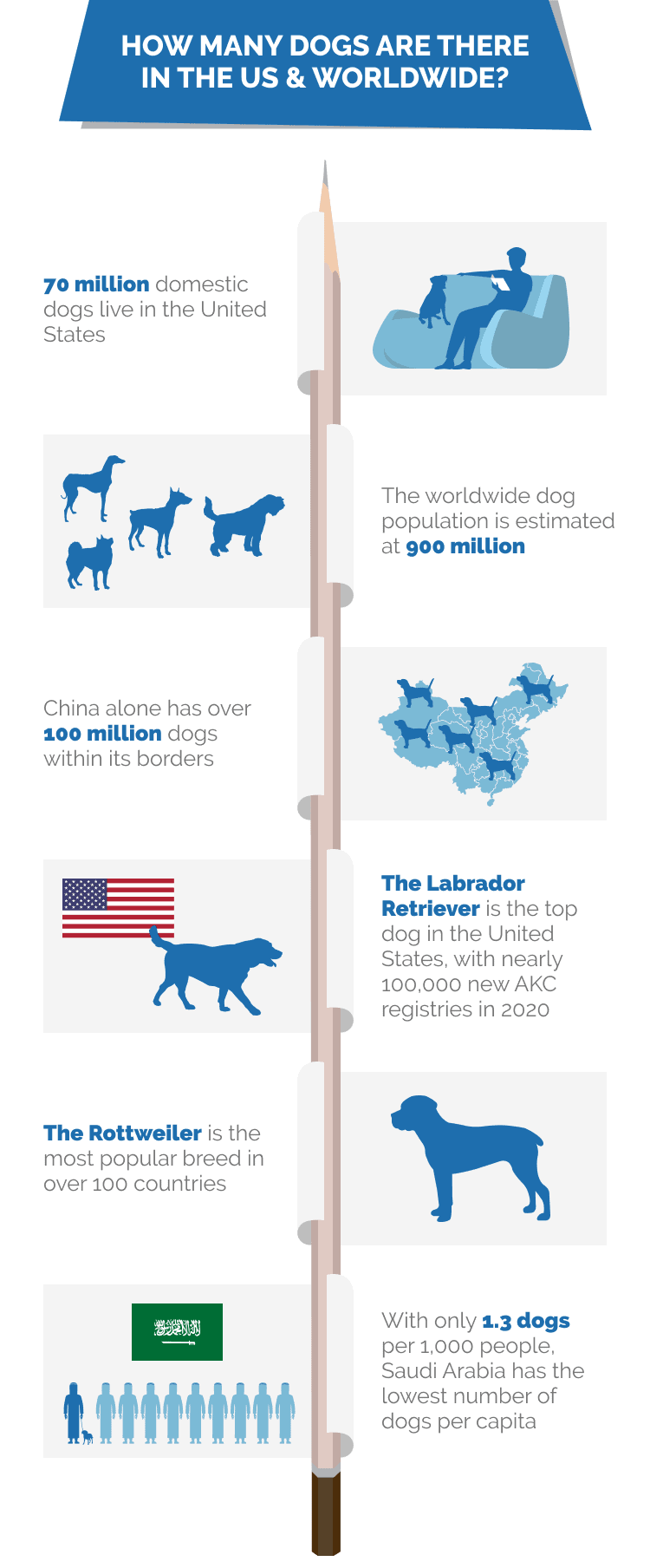How Many Dogs Are There in the US & Worldwide? 2024 Updated Statistics
By Brooke Bundy
Updated on

Click to Skip Ahead
Note: This article’s statistics come from third-party sources and do not represent the opinions of this website.
The United States may have the highest rate of dog ownership per capita, but they don’t even own 10% of the global canine population. There are around 70 million domestic dogs living in the United States and around 900 million worldwide. As it turns out, many cultures enthusiastically embrace adopting a dog, especially European countries where they’re treated more like humans than animals. Countries tend to have their own favorite breeds, and most don’t share the American enthusiasm for breeds such as the Labrador Retriever and the Pit Bull. Some countries highly discourage dog ownership because they’re seen as unclean animals in the popular religion of the region, such as in predominantly Islamic areas. Let’s see how different cultures consider canines within their territories and take a peek at the world outlook for dogs.
The 10 Dog Population Statistics
- 70 million domestic dogs live in the United States.
- The worldwide dog population is estimated at 900 million.
- With over 100 million within its borders, China has the most dogs by the numbers.
- South Koreans are 9x as likely to adopt a dog than a cat.
- The Labrador Retriever is the top dog in the United States, with nearly 100,000 new AKC registries in 2020.
- The Rottweiler is the most popular breed in over 100 countries.
- With only 1.3 dogs per 1,000 people, Saudi Arabia has the lowest number of dogs per capita.
- Pit Bull breeds are banned in 12 countries.
- European dogs live a year longer on average than dogs in the United States.
- The oldest dog in the world on record lived to a ripe old age of 29 years.

Counting Canines by the Country
1. 70 million domestic dogs live in the United States.
(World Population Review)
The United States ranks #1 in dog ownership per capita. China actually has more dogs within their borders, but their population is also five times greater which skews the statistics. If we’re counting canines per capita, Brazil ranks #2.

2. The worldwide dog population is estimated at 900 million.
(World Atlas)
The World Health Organization estimates that the global dog population is somewhere around 900 million. In less developed countries, stray dogs are more common than dogs kept as pets, so it’s uncertain how many of these 900 million dogs have homes.
3. With over 100 million within its borders, China has the most dogs by the numbers.
(Quotation Check, Statista)
They may have the largest number of dogs, but they also have 1.41 billion humans, so it makes sense. China is the original home of several ancient dog breeds that are now internationally adored, such as the Pug and the Chow Chow. Currently, the Siberian Husky is the most popular dog breed in China.
4. South Koreans are 9x as likely to adopt a dog than a cat.
(Psychology Today, Statista)
Although attitudes are slowly changing, some South Koreans still hold cats in suspicion and consider them to be a bad omen. Dogs, however, are welcomed with open arms. In 2020, there were an estimated 5.2 million pet dogs in South Korea, which was actually a slight decrease from over 6 million in recent years.
 The World’s Most Popular Breeds
The World’s Most Popular Breeds
5. The Labrador Retriever is the top dog in the United States, with nearly 100,000 new AKC registries in 2020.
(NPR, Associated Press)
The Labrador Retriever has enjoyed a 30-year streak as the most popular dog breed in America. Energetic, loyal, and possessing a gentle heart, it’s not hard to see why. Labradors are easy, go lucky animals who will follow you anywhere, and are typically up for a good romp in the park. However, the French Bulldog may likely usurp their position in the near future. Americans are increasingly urbanizing and spending less time outdoors, which makes a small breed more attractive. Currently, the Frenchie holds the #2 spot, with 66,500 joining the AKC in 2020.

6. The Rottweiler is the most popular breed in over 100 countries.
(Finder)
While the Rottweiler rests at #9 in the United States, more than 100 countries consider them to be the top dog. Because of the city of Paris, you might think the most popular dog in France would be a small breed that you can take to a bistro, like a Toy Poodle or a Bichon. Surprisingly, the Rottweiler is also the #1 dog in France.
Global Restrictions on Dog Ownership
7. With only 1.3 dogs per 1,000 people, Saudi Arabia has the lowest number of dogs per capita.
(Psychology Today, Quartz)
Islamic countries today typically have the lowest dog ownership rates due to the religious belief that dogs are unclean. Interestingly, this is a new teaching that wasn’t a part of the original Islamic practice. Dogs only became associated with uncleanliness in the last couple hundred years because people linked them to the spread of contagious diseases. This belief isn’t consistent across all Islamic countries, since not all Muslims adhere to the modern tradition. Indeed, history tells us that Mohammed himself loved dogs.
8. Pit Bull breeds are banned in 12 countries.
(World Population Review, Independent)
Starting in the 1990s, countries began to impose Pit Bull bans after they were perceived to be a dangerous breed. Some countries only prohibited further importation while allowing citizens to keep existing Bullies as pets, such as Australia. Other places, such as Germany, enacted a harsher ban that resulted in a partial genocide. Following an incident in 2000 where a child was suddenly killed at school by a Pit Bull who jumped the fence, Germany implemented strenuous aggression testing for the breed. Any dog who didn’t pass was put to death.

 How Dogs Age Worldwide
How Dogs Age Worldwide
9. European dogs live a year longer on average than dogs in the United States.
(Finances Online, Tokyo University of Agriculture and Technology)
Humans and their canine companions live longer in European countries than they do in the United States. European dogs live about a year longer on average. In Japan—another country where humans live longer than they do in America—dogs have an average 13.2-year lifespan, compared to only 10–13 years in the United States.
10. The oldest dog in the world on record lived to a ripe old age of 29 years.
(Guinness World Records, Penguin)
An Australian Blue Heeler named Bluey took the crown during the 1930s as the world’s oldest dog. He spent his many days on a farm, just like Maggie, an Australian Kelpie who reportedly passed away in 2016 after living at least 30 years. Unfortunately, Maggie didn’t have any records to prove her age, so she was unable to claim the Guinness title.
Frequently Asked Questions About Global Dog Ownership
Are dogs allowed in every country?
Most countries allow canines of some sort but may have breed restrictions or tougher requirements for ownership. For example, Pit Bull breeds such as the Staffordshire Terrier are banned at least partially in 12 countries. Some countries discourage dog ownership but don’t ban the practice outright, such as Saudi Arabia where canines are largely considered unclean. Even so, there is an extensive list of banned breeds.
(Pet Relocation)
How does dog ownership work in other countries?
For better or for worse, pet ownership looks different depending on where you live. Whereas in the United States, you can acquire pets from anywhere, in other parts of the world they may be stricter about licensing and may limit how many dogs you can own. For example, in most Australian states you can only own up to two dogs without obtaining a domestic dog permit. Even after obtaining a permit, you can only have up to four total. There are laws in the United States which limit how many pets you can have as well, but they’re usually more dependent on local governments than state or federal regulations.
(Brisbane City Council)

What’s the world’s most popular dog breed?
In a list of top dog breeds around the world, the Rottweiler is mentioned the most. The Maltese follows second. This toy breed is a favorite mostly among Mediterranean and Arabic countries. Of course, these countries have a much smaller population than countries such as China and the United States, where the Siberian Husky and the Labrador Retriever, respectively, enjoy the most popular dog status. Thus, there may not actually be more Rottweilers and Malteses in the world than the favorite breeds of the more populated countries.
(Finder)
Final Thoughts
While there are more cats than dogs in the world, canines are currently the world’s favorite pet. Some countries, such as South Korea, prefer dogs nine times over due to deeply rooted superstitions about felines. Unfortunately, a large percentage of the 900 million dogs in the world likely live on the street. Hopefully things will look up for dogs and cats as the idea of these creatures shifts from mere work animals or bad omens to pets who need homes.
Featured Image Credit: Rita Kochmarjova, Shutterstock














